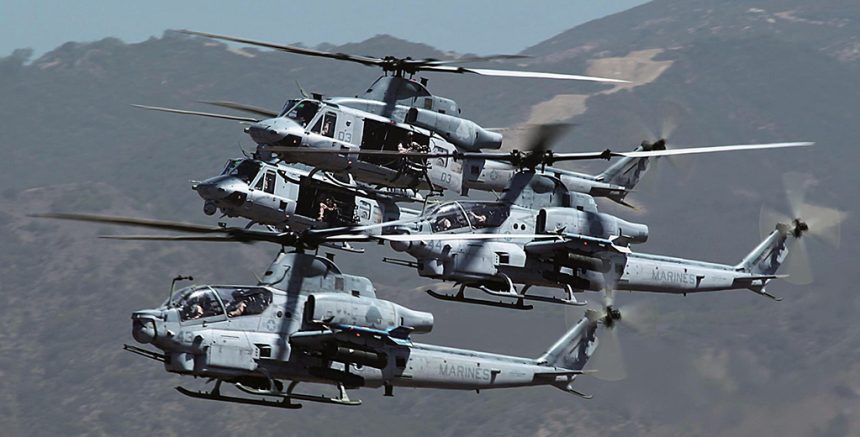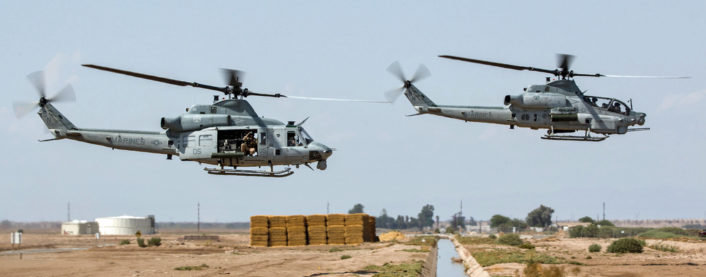During Flying The Barn exercise U.S. Marine Light Attack Helicopter Squadron 369 launched a unique assault formation made of AH-1Z Viper attack and UH-1Y Venom tactical transport helicopters.
On Nov. 4, 2016, U.S. Marines from Marine Light Attack Helicopter Squadron (HMLA) 369 took part in an exercise known as “Flying the Barn” on Marine Corps Base Camp Pendleton, California.
The video below is titled “Flying the Barn” in reference to the slang used for putting every aircraft “in the barn” up in the air at once, a rare sight at any military installation.
During the Exercise, U.S. Marine Light Attack Helicopter Squadron 369 launched a unique assault formation of their advanced version AH-1Z Viper attack helicopter and their UH-1Y Venom tactical transport.
The formation is interesting since the U.S. Marines are the only operators of the “Viper” and “Venom” advanced helicopter variants. These aircraft are descendents of the legacy AH-1 Cobra and UH-1 Huey helicopters. The continued operation of these two greatly evolved platforms seems at odds with new aircraft now in use by the U.S. Marines, the MV-22 Osprey tilt-rotor aircraft and the F-35B Lightning II V/STOL variant of the Joint Strike Fighter.
Despite the long history of their predecessors, the original Huey and Cobra, the highly evolved AH-1Z Viper and UH-1Y Venom are very advanced combat aircraft that are easily contemporaries of the newer MV-22 Osprey and even the F-35B Lightning II.
The AH-1Z Viper flies on a new carbon fiber composite four-blade rotor system with 75% fewer moving parts in the vulnerable rotor mast despite having two additional blades compared to early Cobra gunships. The “Zulu” gunships have larger winglet weapon stations that can mount AIM-9 Sidewinder infrared guided air-to-air missiles in addition to air-to-ground rockets and guided missiles. The AH-1Z also has reshaped engine cowling and exhaust to reduce infrared signature for evading heat-seeking anti-aircraft missiles. Viper flight crews wear an advanced flight helmet integrated into aircraft avionics and equipped with recently enhanced night vision and target queuing.
The heavily updated four-bladed UH-1Y Venom is an adaptation of the legacy Huey platform but with massive upgrades making it essentially a new helicopter.
Also updated to a large four-blade rotor as with the AH-1Z Viper, the Venom has battle-damage resistant composite rotor blades and a new, simplified mast system. The rotor upgrades provide significantly greater lift, range and speed on the Venom. Although usually operated in formation with its Marine companion, the AH-1Z Viper, the UH-1Y Venom can transport Marines and also carry its own ground attack weapons. The Venom can mount 2.75-inch rockets on each winglet including the newest “smart” Advanced Precision Kill Weapon System (APKWS) laser-guided rocket from BAE Systems.
U.S. Marine Light Attack Helicopter Squadron 369 has an impressive legacy that includes being the first Marine Corps unit to fly the Cobra attack helicopter in a combat operation back in 1972 during the Vietnam conflict.
Both of these aircraft are common sights around the massive Camp Pendleton Marine Base in southern California. If you are driving between San Diego and Los Angeles on the Interstate 5 coastal highway it is common to see the aircraft flying, but not in the numbers seen in this video. Seeing these unique variants of both aircraft is a treat since the U.S. Marines are the only service to fly them and employ unique tactics with the aircraft making them interesting.
Related articles

















